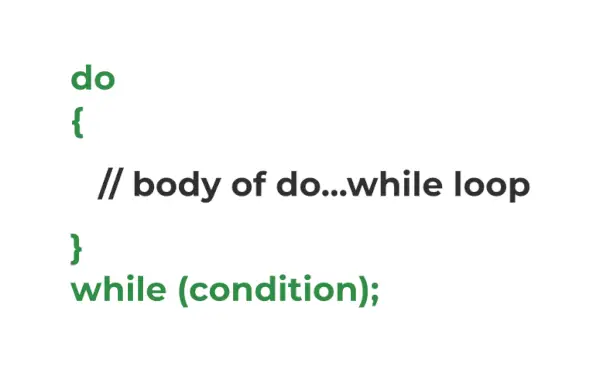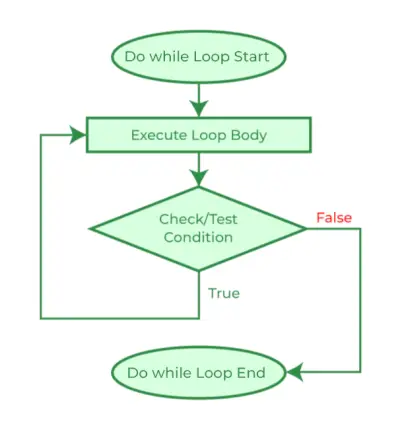Cilpas C valodā ir vadības plūsmas priekšraksti, kas tiek izmantoti, lai atkārtotu kādu koda daļu, līdz tiek izpildīts noteiktais nosacījums. The do-while cilpa ir viens no trim cilpas priekšrakstiem valodā C, pārējie ir while loop un for loop. To galvenokārt izmanto, lai šķērsotu masīvus, vektorus un citas datu struktūras.
Kas ir darīt... kamēr cilpa C?
The darīt... kamēr C ir cilpas paziņojums, ko izmanto, lai atkārtotu kādu koda daļu, līdz tiek izpildīts noteiktais nosacījums. Tā ir forma an izejas kontrolēta vai pēcpārbaudīta cilpa kur pārbaudes stāvoklis tiek pārbaudīts pēc cilpas korpusa izpildes. Sakarā ar to cilpas do…while paziņojumi vienmēr tiks izpildīti vismaz vienu reizi neatkarīgi no nosacījuma.
Sintakse do… kamēr cilpa valodā C
do { // body of do-while loop } while ( condition );> Kā lietot do… kamēr cilpa C
Šis piemērs parāda do…while cilpas lietošanu C programmēšanas valodā.
C
// C Program to demonstrate the use of do...while loop> #include> int> main()> {> >// loop variable declaration and initialization> >int> i = 0;> >// do while loop> >do> {> >printf>(>'Geeks
'>);> >i++;> >}>while> (i <3);> >return> 0;> }> |
>
>Izvade
Geeks Geeks Geeks>
Kā darbojas... kamēr Loop darbojas?

Sintakse Cilpas do while struktūra
Tālāk ir izskaidrota cilpas do…while darbība:
- Kad programmas vadība pirmo reizi nonāk pie do…while cilpas, vispirms tiek izpildīts cilpas pamatteksts un pēc tam tiek pārbaudīts testa nosacījums/izteiksme , atšķirībā no citām cilpām, kur vispirms tiek pārbaudīts testa stāvoklis. Šīs īpašības dēļ cilpa do…while tiek saukta arī par izeju kontrolētu vai pēcpārbaudītu cilpu.
- Kad testa stāvoklis tiek novērtēts kā taisnība , programmas vadība iet uz sākumu no cilpas un ķermenis tiek izpildīts vēlreiz.
- Iepriekš minēto procesu atkārto, līdz testa nosacījums ir patiess.
- Kad testa stāvoklis tiek novērtēts kā viltus, programmas vadīklas pāriet uz nākamajiem paziņojumiem pēc do…while cilpas.
Tāpat kā C cilpas while gadījumā, inicializācija un atjaunināšana nav daļa no do…while cilpas sintakses. Mums tas ir skaidri jādara attiecīgi pirms un cilpas laikā.
Tālāk esošajā blokshēmā ir redzams do...while cilpas plūsmas vizuālais attēlojums formātā C.
C do… kamēr cilpas blokshēma

Darbības blokshēma, kamēr cilpa C
Nested do… kamēr cilpa C
Tāpat kā ar citām cilpām, mēs varam arī ievietot vienu cilpu, vienlaikus veidojot cilpu citā cilpā. Tas tiek parādīts, izmantojot šādu C programmu.
Nested do… piemērs, kamēr cilpa C:
C
// C Program to demonstrate the nesting of do...while loop> #include> int> main()> {> >// declaring loop variables> >int> i = 0, j;> >int> count = 0;> >// outer loop starts> >do> {> >j = 0;> >// inner loop starts> >do> {> >printf>(>'%d '>, count++);> >j++;> >}>while> (j <3);> >// inner loop ends> >printf>(>'
'>);> >i++;> >}>while> (i <3);> >// outer loop ends> >return> 0;> }> |
>
>Izvade
0 1 2 3 4 5 6 7 8>
Lai uzzinātu vairāk par ligzdotajām cilpām programmā C, skatiet šo rakstu — C ligzdotas cilpas ar piemēriem
Piemēri do…, kamēr cilpa C
Piemērs 1. C Programma, lai demonstrētu do…while cilpas uzvedību, ja nosacījums ir nepatiess jau no paša sākuma.
C
bloķēti numuri
// C Program to demonstrate the do...while loop behaviour> // when the condition is false from the start> #include> #include> int> main()> {> >// declaring a false variable> >bool> condition =>false>;> >do> {> >printf>(>'This is loop body.'>);> >}>while> (condition);>// false condition> >return> 0;> }> |
>
>Izvade
This is loop body.>
Kā redzam, pat tad, ja nosacījums sākumā ir nepatiess, cilpas pamatteksts tiek izpildīts vienreiz. Tas ir tāpēc, ka cilpas do…while stāvoklis tiek pārbaudīts pēc ķermeņa iziešanas, tāpēc, kad kontrole ir sākumā,
- Tas iet cauri cilpas korpusam.
- Izpilda visus ķermeņa paziņojumus.
- Pārbauda nosacījumu, kas izrādās nepatiess.
- Pēc tam iziet no cilpas.
2. piemērs. C Programma N reizināšanas tabulas drukāšanai, izmantojot do…while cilpu
Šis piemērs parāda do…while cilpas izmantošanu N reizināšanas tabulas drukāšanai.
C
// C Program to print multiplication table using do...while> // loop> #include> int> main()> {> >int> N = 5, i = 1;> >do> {> >printf>(>'%d x %d = %d
'>, N, i, N * i);> >}>while> (i++ <10);> >return> 0;> }> |
>
xvideoservicethief ubuntu 14.04 lejupielāde
>Izvade
5 x 1 = 5 5 x 2 = 10 5 x 3 = 15 5 x 4 = 20 5 x 5 = 25 5 x 6 = 30 5 x 7 = 35 5 x 8 = 40 5 x 9 = 45 5 x 10 = 50>
Atšķirība starp while un do...when Loop in C
Nākamajā tabulā ir uzskaitīti svarīgākie atšķirības starp while un do...while Loop C.
| kamēr Loop | darīt... kamēr Loop |
|---|---|
| Pārbaudes stāvoklis tiek pārbaudīts pirms tiek izpildīts cilpas korpuss. | Pārbaudes stāvoklis tiek pārbaudīts pēc ķermeņa izpildīšanas. |
| Ja nosacījums ir nepatiess, ķermenis netiek izpildīts pat ne reizi. | Ķermenis do...kamēr cilpa tiek izpildīta vismaz vienu reizi pat tad, ja nosacījums ir nepatiess. |
| Tas ir veids iepriekš pārbaudīta vai ieejas kontrolēta cilpa. | Tas ir veids pēcpārbaudīta vai izejas kontrolēta cilpa. |
| Semikols nav nepieciešams. | Semikols ir nepieciešams beigās. |
Lai uzzinātu vairāk par šīm atšķirībām, lūdzu, skatiet šo rakstu – Atšķirība starp while un do-while cilpu programmās C, C++, Java
Secinājums
Noslēgumā jāsaka, ka vienīgās ar izeju kontrolētās cilpas C, do…while cilpas izmantošana ir paredzēta arī noteiktas koda daļas atkārtošanai, taču tās darbības veids atšķiras no ieejas kontrolētajām cilpām, piemēram, cilpas while un for. cilpa. Tas ir noderīgi gadījumos, kad paziņojums ir jāizpilda cilpas pamattekstā vismaz vienu reizi, piemēram, šķērsojot cirkulāri saistītos sarakstus.
Bieži uzdotie jautājumi par C do… kamēr Loops
1. Cik cilpu veidu ir C?
Gadi: C valodā ir 3 veidu cilpas:
- priekš Loop
- kamēr Loop
- darīt... kamēr Loop
2. Kas ir ieejas kontrolētās vai iepriekš pārbaudītās cilpas?
Gadi: Ieejas kontrolētās cilpas vai iepriekš pārbaudītās cilpas ir tās cilpas, kurās cilpa stāvoklis tiek pārbaudīts pirms ķermeņa izpildes no cilpas.
3. Kas ir izejas kontrolētās vai pēcpārbaudītās cilpas?
Gadi: Ar izeju kontrolētās cilpas vai pēcpārbaudītās cilpas ir tās cilpas, kurās programmas vadība nonāk cilpas pamattekstā pirms cilpas stāvokļa pārbaudes .
4. Kura cilpa tiek garantēta, ka tā tiks izpildīta vismaz vienu reizi?
Gadi: The darīt… kamēr cilpa tiek garantēts, ka vismaz vienu reizi izpildīs paziņojumus cilpas pamattekstā, jo tas ir ar izeju kontrolētas cilpas veids.
5. Vai mēs varam izlaist iekavas C do...while cilpas sintakse, ja pamattekstā ir tikai viens paziņojums?
Atbilde: Nē. , mēs nevaram izlaist figūriekavas C do...kamēr sintakse, pat ja atšķirībā no cilpas while un for ir tikai viens priekšraksts.
6. Kā izveidot bezgalīgu cilpu C, izmantojot do…while cilpu?
Gadi: Mēs varam izveidot bezgalīgu cilpu programmā C, norādot a nosacījums, kas vienmēr būs patiess kā cilpas nosacījums. Zemāk esošā programma parāda, kā to izdarīt:
C
// C Program to create a infinite loop using do...while loop> // in C> #include> int> main()> {> >// infinite loop> >do> {> >printf>(>'gfg '>);> >}>while> (1);>// always 1 ~ true> >return> 0;> }> |
>
>
Izvade
gfg gfg gfg gfg gfg gfg gfg .... (infinite)>
